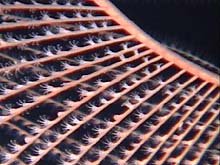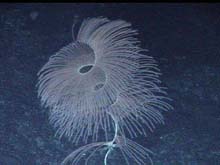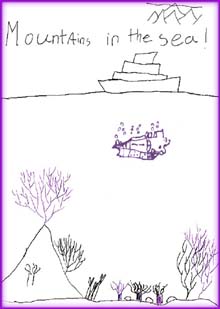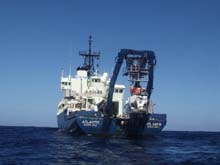
DSV Alvin is launched from the R/V Atlantis for the first dive to Manning seamount. Photo by P. Auster. Click image for larger view.
Corals, corals, corals and rocks!!!!!
July 13, 2003
Diana Payne
Connecticut Sea Grant
Maya Crosby
Lincoln Academy
Strange and beautiful things were brought to us from time to time, which seemed to give us a glimpse of the edge of some unfamiliar world.
- Sir Charles Wyville Thompson, The Challenger Expedition, 1876
Today’s exploration at Manning seamount, Alvin dive number 3901, was a spectacular success! The dive site, carefully planned based on recent information and maps, placed observers Les Watling and Scott France and pilot Phil Forte among a plethora of deep-sea corals. At least seven different species were identified over a span of only 150-200 meters.
Dr. Watling described an amazing field of corals, with giant Iridogorgia gently spiraling upward every few meters as far as the Alvin team could see. “It was amazing to see this many corals in one place,” said Watling. These corals have branches coming off their ‘trunks’ on one side, and look like giant Slinkies rising about 6 feet. There were also large Lepidisis (sea whips) and Metallogorgia (umbrella corals). “I looked above the Alvin and still couldn’t see the tops of these giant coral trees,” Watling said about the size of the Lepidisis.
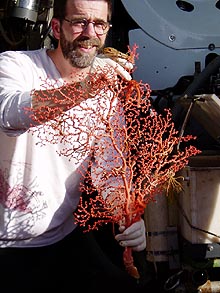
Scott France, College of Charleston, holds up a deep sea coral collected from the dive. Photo by M. Crosby. Click image for larger view.
A cumacean (small shrimp-like crustacean) was spotted in a Metallogorgia during the dive, which is a rare sighting at that depth. The dive location was all that the science team had dreamed of! Dr. Scott France remarked “It was more than I had hoped for – more coral diversity than I’ve seen before on any single dive, and that includes Hawaii!” Dr. Les Watling said, "I saw cumaceans AND gorgonians, my two favorite species, in one place!’
Dr. Watling also observed what might be a unique behavior of a sea star species. He described a small, light reddish purple sea star that had a funnel of tissue protruding from an area near its anus. Watling noted that the sea star “blew a large amount of water” through this funnel-shaped pouch. Back on board the ship, he identified the sea star as a Hymenaster sp, possibly pellucidus. This species may brood its young, which means it holds them in a pouch on its body. One of the possible explanations for the behavior is that the sea star was releasing its offspring. This behavior has never before been observed or described. Other possibilities are that the funnel-shaped pouch could be for respiration, feeding, or excretion. It could also be similar to an osculum, an opening seen in sponges that is used both for excretion and for brooding young.
Graduate student Betsy Grannis showed everyone a species of deep sea coral (Lepidisis sp.) that fluoresced when it was touched. Many in the science team followed Betsy into the dark cold room to see this fascinating glow-in-the-dark coral!
The scientists were satisfied that so many of the coral, sea star and other species samples were brought up relatively unharmed, and seemed to survive well after an immediate cold water bath. After a dive, samples are placed in buckets and brought to the cold room, while scientists and students scramble to preserve them in fixative before the organisms begin to die and degrade. This process is important so as to preserve as much of the natural physical state of the organisms for thorough examination back in the lab. Additional science activities include taking small samples of deep-sea coral eggs and fixing them for DNA analysis. Graduate student Anne Simpson is pleased to have coral eggs in a healthy state.
Along with the numerous coral samples, the science team quickly retrieved their own personal treasures, which were nearly as colorful as the coral landscape. The seemingly age-old tradition of decorating Styrofoam cups, placing them in a mesh bag, and attaching the bag to the Alvin prior to a dive is likely to be repeated during the six more dives scheduled for this expedition.
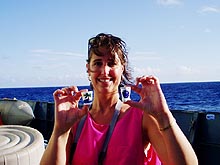
Educator Melissa Ryan holds up two styrofoam cups compressed by the pressure at depth. Photo by M. Crosby. Click image for larger view.
In the midst of the coral mania after the successful Alvin dive, the rock dredge operations were underway. R/V Atlantis SSSG technician Dave Sims and educator Pat Frisketti kept busy adjusting the scope, angle, and depth of the dredge. The goal is to keep the dredge suspended just above the surface of the seamount with enough scope so that as the vessel pulls forward slowly, allowing the dredge to be eased down into the sediment. After a 15-minute sampling time, 30-40 minutes will be required to bring the dredge on board. When the amount of dredge line let out nears 300 m, the control of the dredge operation was switched over to the main deck, where the recovery of the dredge continued. The science team was on hand to place the contents of the dredge sample in cold water collection buckets. The dredge sample contained sandy sediment and various benthic invertebrate species, such as hard corals and brittle stars.
As the day comes to a close, coral and rock dredge samples are processed. Multibeam sonar is operating to complete the mapping of Manning seamount, and final preparations are made for tomorrow’s Alvin dive. Peter Auster and Jon Moore will be in the sub on dive 3902. They hope to add several species of fish to our list of organisms observed.
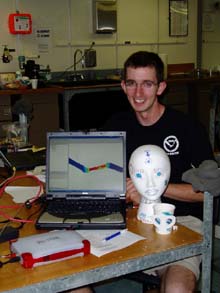
Nick Forfinski, hydrographer for the NOAA Ship Thomas Jefferson. Photo M. Crosby. Click image for larger view.
Interview with Nick Forfinski, NOAA Hydrographer
Nick Forfinski, 24, has come a long way from his hometown of Farwell, MI and his stint as a band director-in-training. He is an invited member of the science team whose task is to analyze the SeaBeam sonar data acquired by the ship, and develop three-dimensional maps. The scientists on board will use these maps to decide where to dive with the Alvin. Today he is making a map of Kelvin Seamount, a seamount about 1600m deep that has never been mapped at high resolution before. We will stop at Kelvin on our return trip, and the scientists will use Nick’s map to decide where to dive. Bathymetric maps provide information that is used to determine dive sites for Alvin, Nick’s contribution to the expedition is very important!
Nick is usually a survey technician on the NOAA Ship Thomas Jefferson, out of Norfolk, VA. His responsibility on this vessel is to acquire and process sonar data used in nautical charting and marine fisheries surveys. This is his first time as a survey tech on a research expedition. He says he is pretty excited to be here after feeling a bit intimidated at first. When asked what he has enjoyed so far about his cruise, he describes the cephalopod puns at lunchtime and his experience eating mussel byssal threads during a pre-cruise seafood dinner.
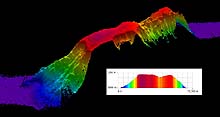
Three-dimensional depiction of a single swath of bathymetric SeaBeam data of Kelvin Seamount. Time constraints in transit resulted in only a single pass over Kelvin Seamount by the R/V Atlantis. We hope to complete the map with several more passes on the return visit. Image by N. Forfinski. Click image for larger view.
Nick says he has found it exciting to be 500 miles offshore, to see Alvin dive for the first time and to experience "all the people on this vessel coming from all different directions, being thrown together."
Nick received a degree from Western Michigan University in environmental resource management. He started his studies as a band director-in-training, but he soon became interested in the sciences. In particular, he got hooked on geography and GIS (geographic information system) because "it involved a little bit of everything."
The hull-mounted SeaBeam system on the R/V Atlantis has 121 beams. (For more information on how this system operates, read the July 8 log from the 2002 Gulf of Alaska cruise.) The system’s transducer sends out sound waves at a frequency of 12 kHz. Depth is then calculated based on the time it takes for these sound waves to return to the transducer.
Nick uses a software system called CARIS (computer aided resource information system) specifically designed for hydrographic surveying to process the bathymetric data. He can then make various images and maps like the one he made of the Kelvin Seamount today.
Nick’s work on this cruise is vitally important to the scientists and their planning of Alvin dives. Nick says his favorite part of being on boats is "staring at water." He’ll have a lot more chances to do that on this cruise!
Interview by Maya Crosby of the Ocean Explorer Team.
Sketch of Mountains in The Sea
MJ Brush, Scientific Illustrator
Among those who log onto the Ocean Explorer Web site are students interested in the daily adventures aboard research vessels, educators, scientists, and the general public, as well as family members of the ship and science crew on board. The science crew on this Atlantis cruise includes researchers, graduate students, teachers, several members of the media, various writers, and an artist.
The artist who drew this image is eight-year-old Jenna Watling. Her father, Dr. Les Watling, is the chief scientist of this cruise. As chief scientist, he wears many hats and is responsible for all scientific aspects of the cruise including data and specimen collection. Jenna drew this sketch during dinner the night before Atlantis left Woods Hole, MA. As you can see, she has a clear idea of just what her father is doing today—he is in Alvin exploring Manning seamount as I write this. Jenna drew her rendition of the ship Atlantis, the Alvin submarine, the underwater mountains, corals, and sponges that are associated with this cruise. My job as the artist connected with this leg of the cruise is to review hours of videotape to paint the mountains deep in the ocean where light does not penetrate so that we might understand the topography and the scope of the seamount. Jenna and I are 50 years apart in age, but my early drawings were very similar to hers. Every time one does a drawing, one trains the eye, the hand and the mind to work together. It requires imagination and practice. No matter what one chooses to be in life—a scientist, a teacher, a writer or an artist—it all takes imagination and practice. All you need is a pencil and a piece of paper. Good luck!




















